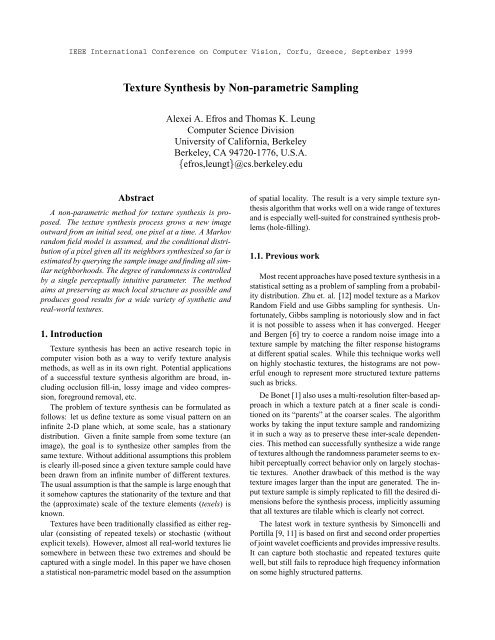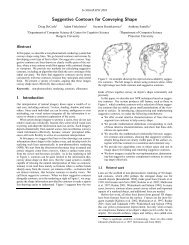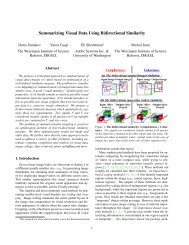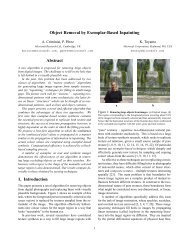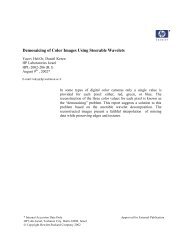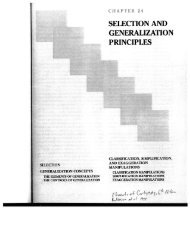Texture Synthesis by Non-parametric Sampling
Texture Synthesis by Non-parametric Sampling
Texture Synthesis by Non-parametric Sampling
Create successful ePaper yourself
Turn your PDF publications into a flip-book with our unique Google optimized e-Paper software.
IEEE International Conference on Computer Vision, Corfu, Greece, September 1999<br />
<strong>Texture</strong> <strong>Synthesis</strong> <strong>by</strong> <strong>Non</strong>-<strong>parametric</strong> <strong>Sampling</strong><br />
Alexei A. Efros and Thomas K. Leung<br />
Computer Science Division<br />
University of California, Berkeley<br />
Berkeley, CA 94720-1776, U.S.A.<br />
efros,leungt@cs.berkeley.edu<br />
Abstract<br />
A non-<strong>parametric</strong> method for texture synthesis is proposed.<br />
The texture synthesis process grows a new image<br />
outward from an initial seed, one pixel at a time. A Markov<br />
random field model is assumed, and the conditional distribution<br />
of a pixel given all its neighbors synthesized so far is<br />
estimated <strong>by</strong> querying the sample image and finding all similar<br />
neighborhoods. The degree of randomness is controlled<br />
<strong>by</strong> a single perceptually intuitive parameter. The method<br />
aims at preserving as much local structure as possible and<br />
produces good results for a wide variety of synthetic and<br />
real-world textures.<br />
1. Introduction<br />
<strong>Texture</strong> synthesis has been an active research topic in<br />
computer vision both as a way to verify texture analysis<br />
methods, as well as in its own right. Potential applications<br />
of a successful texture synthesis algorithm are broad, including<br />
occlusion fill-in, lossy image and video compression,<br />
foreground removal, etc.<br />
The problem of texture synthesis can be formulated as<br />
follows: let us define texture as some visual pattern on an<br />
infinite 2-D plane which, at some scale, has a stationary<br />
distribution. Given a finite sample from some texture (an<br />
image), the goal is to synthesize other samples from the<br />
same texture. Without additional assumptions this problem<br />
is clearly ill-posed since a given texture sample could have<br />
been drawn from an infinite number of different textures.<br />
The usual assumption is that the sample is large enough that<br />
it somehow captures the stationarity of the texture and that<br />
the (approximate) scale of the texture elements (texels) is<br />
known.<br />
<strong>Texture</strong>s have been traditionally classified as either regular<br />
(consisting of repeated texels) or stochastic (without<br />
explicit texels). However, almost all real-world textures lie<br />
somewhere in between these two extremes and should be<br />
captured with a single model. In this paper we have chosen<br />
a statistical non-<strong>parametric</strong> model based on the assumption<br />
of spatial locality. The result is a very simple texture synthesis<br />
algorithm that works well on a wide range of textures<br />
and is especially well-suited for constrained synthesis problems<br />
(hole-filling).<br />
1.1. Previous work<br />
Most recent approaches have posed texture synthesis in a<br />
statistical setting as a problem of sampling from a probability<br />
distribution. Zhu et. al. [12] model texture as a Markov<br />
Random Field and use Gibbs sampling for synthesis. Unfortunately,<br />
Gibbs sampling is notoriously slow and in fact<br />
it is not possible to assess when it has converged. Heeger<br />
and Bergen [6] try to coerce a random noise image into a<br />
texture sample <strong>by</strong> matching the filter response histograms<br />
at different spatial scales. While this technique works well<br />
on highly stochastic textures, the histograms are not powerful<br />
enough to represent more structured texture patterns<br />
such as bricks.<br />
De Bonet [1] also uses a multi-resolution filter-based approach<br />
in which a texture patch at a finer scale is conditioned<br />
on its “parents” at the coarser scales. The algorithm<br />
works <strong>by</strong> taking the input texture sample and randomizing<br />
it in such a way as to preserve these inter-scale dependencies.<br />
This method can successfully synthesize a wide range<br />
of textures although the randomness parameter seems to exhibit<br />
perceptually correct behavior only on largely stochastic<br />
textures. Another drawback of this method is the way<br />
texture images larger than the input are generated. The input<br />
texture sample is simply replicated to fill the desired dimensions<br />
before the synthesis process, implicitly assuming<br />
that all textures are tilable which is clearly not correct.<br />
The latest work in texture synthesis <strong>by</strong> Simoncelli and<br />
Portilla [9, 11] is based on first and second order properties<br />
of joint wavelet coefficients and provides impressive results.<br />
It can capture both stochastic and repeated textures quite<br />
well, but still fails to reproduce high frequency information<br />
on some highly structured patterns.
1.2. Our Approach<br />
In his 1948 article, A Mathematical Theory of Communication<br />
[10], Claude Shannon mentioned an interesting way<br />
of producing English-sounding written text using Ò-grams.<br />
The idea is to model language as a generalized Markov<br />
chain: a set of Ò consecutive letters (or words) make up<br />
an Ò-gram and completely determine the probability distribution<br />
of the next letter (or word). Using a large sample<br />
of the language (e.g., a book) one can build probability tables<br />
for each Ò-gram. One can then repeatedly sample from<br />
this Markov chain to produce English-sounding text. This<br />
is the basis for an early computer program called MARK V.<br />
SHANEY, popularized <strong>by</strong> an article in Scientific American<br />
[4], and famous for such pearls as: “I spent an interesting<br />
evening recently with a grain of salt”.<br />
This paper relates to an earlier work <strong>by</strong> Popat and Picard<br />
[8] in trying to extend this idea to two dimensions. The three<br />
main challenges in this endeavor are: 1) how to define a unit<br />
of synthesis (a letter) and its context (Ò-gram) for texture,<br />
2) how to construct a probability distribution, and 3) how to<br />
linearize the synthesis process in 2D.<br />
Our algorithm “grows” texture, pixel <strong>by</strong> pixel, outwards<br />
from an initial seed. We chose a single pixel Ô as our unit<br />
of synthesis so that our model could capture as much high<br />
frequency information as possible. All previously synthesized<br />
pixels in a square window around Ô (weighted to emphasize<br />
local structure) are used as the context. To proceed<br />
with synthesis we need probability tables for the distribution<br />
of Ô, given all possible contexts. However, while for<br />
text these tables are (usually) of manageable size, in our texture<br />
setting constructing them explicitly is out of the question.<br />
An approximation can be obtained using various clustering<br />
techniques, but we choose not to construct a model<br />
at all. Instead, for each new context, the sample image is<br />
queried and the distribution of Ô is constructed as a histogram<br />
of all possible values that occurred in the sample<br />
image as shown on Figure 1. The non-<strong>parametric</strong> sampling<br />
technique, although simple, is very powerful at capturing<br />
statistical processes for which a good model hasn’t been<br />
found.<br />
2. The Algorithm<br />
In this work we model texture as a Markov Random<br />
Field (MRF). That is, we assume that the probability distribution<br />
of brightness values for a pixel given the brightness<br />
values of its spatial neighborhood is independent of the rest<br />
of the image. The neighborhood of a pixel is modeled as a<br />
square window around that pixel. The size of the window<br />
is a free parameter that specifies how stochastic the user believes<br />
this texture to be. More specifically, if the texture is<br />
presumed to be mainly regular at high spatial frequencies<br />
and mainly stochastic at low spatial frequencies, the size of<br />
the window should be on the scale of the biggest regular<br />
feature.<br />
Figure 1. Algorithm Overview. Given a sample texture image<br />
(left), a new image is being synthesized one pixel at<br />
a time (right). To synthesize a pixel, the algorithm first<br />
finds all neighborhoods in the sample image (boxes on the<br />
left) that are similar to the pixel’s neighborhood (box on<br />
the right) and then randomly chooses one neighborhood and<br />
takes its center to be the newly synthesized pixel.<br />
2.1. Synthesizing one pixel<br />
Let Á be an image that is being synthesized from a texture<br />
sample image Á ×ÑÔ Á ÖÐ where Á ÖÐ is the real infinite<br />
texture. Let Ô ¾ Á be a pixel and let ´Ôµ Á be a<br />
square image patch of width Û centered at Ô. Let ´ ½ ¾ µ<br />
denote some perceptual distance between two patches. Let<br />
us assume for the moment that all pixels in Á except for Ô<br />
are known. To synthesize the value of Ô we first construct<br />
an approximation to the conditional probability distribution<br />
È ´Ô´Ôµµ and then sample from it.<br />
Based on our MRF model we assume that Ô is independent<br />
of Á Ò ´Ôµ given ´Ôµ. If we define a set<br />
Å´Ôµ ¼<br />
Á ÖÐ ´ ¼ ´Ôµµ ¼<br />
containing all occurrences of ´Ôµ in Á ÖÐ , then the conditional<br />
pdf of Ô can be estimated with a histogram of all center<br />
pixel values in Å´Ôµ. 1 Unfortunately, we are only given<br />
Á ×ÑÔ , a finite sample from Á ÖÐ , which means there might<br />
not be any matches for ´Ôµ in Á ×ÑÔ . Thus we must use a<br />
heuristic which will let us find a plausible Å ¼´Ôµ Å´Ôµ<br />
to sample from. In our implementation, a variation of<br />
the nearest neighbor technique is used: the closest match<br />
×Ø ÖÑÒ ´´Ôµµ Á ×ÑÔ is found, and all image<br />
patches with ´´Ôµµ ´½ · ¯µ´´Ôµ ×Ø µ are<br />
included in Å ¼´Ôµ, where ¯ ¼½ for us. The center pixel<br />
values of patches in Å ¼´Ôµ give us a histogram for Ô, which<br />
can then be sampled, either uniformly or weighted <strong>by</strong> .<br />
Now it only remains to find a suitable distance . One<br />
choice is a normalized sum of squared differences metric<br />
ËË . However, this metric gives the same weight to any<br />
mismatched pixel, whether near the center or at the edge<br />
of the window. Since we would like to preserve the local<br />
structure of the texture as much as possible, the error for<br />
1 This is somewhat misleading, since if all pixels in Å´Ôµ except Ô are<br />
known, the pdf for Ô will simply be a delta function for all but highly<br />
stochastic textures, since a single pixel can rarely be a feature <strong>by</strong> itself.
(a)<br />
(b)<br />
(c)<br />
Figure 2. Results: given a sample image (left), the algorithm synthesized four new images with neighborhood windows of<br />
width 5, 11, 15, and 23 pixels respectively. Notice how perceptually intuitively the window size corresponds to the degree of<br />
randomness in the resulting textures. Input images are: (a) synthetic rings, (b) Brodatz texture D11, (c) brick wall.<br />
near<strong>by</strong> pixels should be greater than for pixels far away. To<br />
achieve this effect we set ËË £ where isatwodimensional<br />
Gaussian kernel.<br />
2.2. Synthesizing texture<br />
In the previous section we have discussed a method of<br />
synthesizing a pixel when its neighborhood pixels are already<br />
known. Unfortunately, this method cannot be used<br />
for synthesizing the entire texture or even for hole-filling<br />
(unless the hole is just one pixel) since for any pixel the values<br />
of only some of its neighborhood pixels will be known.<br />
The correct solution would be to consider the joint probability<br />
of all pixels together but this is intractable for images<br />
of realistic size.<br />
Instead, a Shannon-inspired heuristic is proposed, where<br />
the texture is grown in layers outward from a 3-<strong>by</strong>-3 seed<br />
taken randomly from the sample image (in case of hole filling,<br />
the synthesis proceeds from the edges of the hole). Now<br />
for any point Ô to be synthesized only some of the pixel values<br />
in ´Ôµ are known (i.e. have already been synthesized).<br />
Thus the pixel synthesis algorithm must be modified to handle<br />
unknown neighborhood pixel values. This can be easily<br />
done <strong>by</strong> only matching on the known values in ´Ôµ and<br />
normalizing the error <strong>by</strong> the total number of known pixels<br />
when computing the conditional pdf for Ô. This heuristic<br />
does not guarantee that the pdf for Ô will stay valid as the<br />
rest of ´Ôµ is filled in. However, it appears to be a good<br />
approximation in practice. One can also treat this as an initialization<br />
step for an iterative approach such as Gibbs sampling.<br />
However, our trials have shown that Gibbs sampling<br />
produced very little improvement for most textures. This<br />
lack of improvement indicates that the heuristic indeed provides<br />
a good approximation to the desired conditional pdf.<br />
3. Results<br />
Our algorithm produces good results for a wide range of<br />
textures. The only parameter set <strong>by</strong> the user is the width Û<br />
of the context window. This parameter appears to intuitively<br />
correspond to the human perception of randomness for most<br />
textures. As an example, the image with rings on Figure 2a<br />
has been synthesized several times while increasing Û. In<br />
the first synthesized image the context window is not big<br />
enough to capture the structure of the ring so only the notion<br />
of curved segments is preserved. In the next image, the<br />
context captures the whole ring, but knows nothing of interring<br />
distances producing a Poisson process pattern. In the<br />
third image we see rings getting away from each other (so<br />
called Poisson process with repulsion), and finally in the<br />
last image the inter-ring structure is within the reach of the<br />
window as the pattern becomes almost purely structured.<br />
Figure 3 shows synthesis examples done on real-world<br />
textures. Examples of constrained synthesis are shown on
(a) (b) (c) (d)<br />
Figure 3. <strong>Texture</strong> synthesis on real-world textures: (a) and (c) are original images, (b) and (d) are synthesized. (a) images<br />
D1, D3, D18, and D20 from Brodatz collection [2], (c) granite, bread, wood, and text (a homage to Shannon) images.
(a)<br />
(b)<br />
Figure 5. Failure examples. Sometimes the growing algorithm<br />
“slips” into a wrong part of the search space and starts<br />
growing garbage (a), or gets stuck at a particular place in the<br />
sample image and starts verbatim copying (b).<br />
Figure 4. Examples of constrained texture synthesis. The<br />
synthesis process fills in the black regions.<br />
Figure 4. The black regions in each image are filled in <strong>by</strong><br />
sampling from that same image. A comparison with De<br />
Bonet [1] at varying randomness settings is shown on Figure<br />
7 using texture 161 from his web site.<br />
4. Limitations and Future Work<br />
As with most texture synthesis procedures, only frontalparallel<br />
textures are handled. However, it is possible to use<br />
Shape-from-<strong>Texture</strong> techniques [5, 7] to pre-warp an image<br />
into frontal-parallel position before synthesis and post-warp<br />
afterwards.<br />
One problem of our algorithm is its tendency for some<br />
textures to occasionally “slip” into a wrong part of the<br />
search space and start growing garbage (Figure 5a) or get<br />
locked onto one place in the sample image and produce verbatim<br />
copies of the original (Figure 5b). These problems<br />
occur when the texture sample contains too many different<br />
types of texels (or the same texels but differently illuminated)<br />
making it hard to find close matches for the neighborhood<br />
context window. These problems can usually be<br />
eliminated <strong>by</strong> providing a bigger sample image. We have<br />
also used growing with limited backtracking as a solution.<br />
In the future we plan to study automatic window-size selection,<br />
including non-square windows for elongated textures.<br />
We are also currently investigating the use of texels<br />
as opposed to pixels as the basic unit of synthesis (similar<br />
to moving from letters to words in Shannon’s setting). This<br />
is akin to putting together a jigsaw puzzle where each piece<br />
has a different shape and only a few can fit together. Currently,<br />
the algorithm is quite slow but we are working on<br />
ways to make it more efficient.<br />
5. Applications<br />
Apart from letting us gain a better understanding of texture<br />
models, texture synthesis can also be used as a tool<br />
for solving several practical problems in computer vision,<br />
graphics, and image processing. Our method is particularly<br />
versatile because it does not place any constraints on the<br />
shape of the synthesis region or the sampling region, making<br />
it ideal for constrained texture synthesis such as holefilling.<br />
Moreover, our method is designed to preserve local<br />
image structure, such as continuing straight lines, so there<br />
are no visual discontinuities between the original hole outline<br />
and the newly synthesized patch.<br />
For example, capturing a 3D scene from several camera<br />
views will likely result in some regions being occluded<br />
from all cameras [3]. Instead of letting them appear as black<br />
holes in a reconstruction, a localized constrained texture<br />
synthesis can be performed to fill in the missing information<br />
from the surrounding region. As another example, consider<br />
the problem of boundary handling when performing<br />
a convolution on an image. Several methods exist, such as<br />
zero-fill, tiling and reflection, however all of them may introduce<br />
discontinuities not present in the original image. In<br />
many cases, texture synthesis can be used to extrapolate the
Figure 6. The texture synthesis algorithm is applied to a real image (left) extrapolating it using itself as a model, to result<br />
in a larger image (right) that, for this particular image, looks quite plausible. This technique can be used in convolutions to<br />
extend filter support at image boundaries.<br />
Our method sample image De Bonet’s method<br />
Figure 7. <strong>Texture</strong> synthesized from sample image with our method compared to [1] at decreasing degree of randomness.<br />
image <strong>by</strong> sampling from itself as shown on Figure 6.<br />
The constrained synthesis process can be further enhanced<br />
<strong>by</strong> using image segmentation to find the exact sampling<br />
region boundaries. A small patch of each region can<br />
then be stored together with region boundaries as a lossy<br />
compression technique, with texture synthesis being used to<br />
restore each region separately. If a figure/ground segmentation<br />
is possible and the background is texture-like, then<br />
foreground removal can be done <strong>by</strong> synthesizing the background<br />
into the foreground segment.<br />
Our algorithm can also easily be applied to motion synthesis<br />
such as ocean waves, rolling clouds, or burning fire<br />
<strong>by</strong> a trivial extension to 3D.<br />
Acknowledgments: We would like to thank Alex Berg,<br />
Elizaveta Levina, and Yair Weiss for many helpful discussions<br />
and comments. This work has been supported <strong>by</strong><br />
NSF Graduate Fellowship to AE, Berkeley Fellowship to<br />
TL, ONR MURI grant FDN00014-96-1-1200, and the California<br />
MICRO grant 98-096.<br />
References<br />
[1] J. S. D. Bonet. Multiresolution sampling procedure for analysis<br />
and synthesis of texture images. In SIGGRAPH ’97,<br />
pages 361–368, 1997.<br />
[2] P. Brodatz. <strong>Texture</strong>s. Dover, New York, 1966.<br />
[3] P. E. Debevec, C. J. Taylor, and J. Malik. Modeling and rendering<br />
architecture from photographs: A hybrid geometryand<br />
image-based approach. In SIGGRAPH ’96, pages 11–<br />
20, August 1996.<br />
[4] A. Dewdney. A potpourri of programmed prose and prosody.<br />
Scientific American, 122-TK, June 1989.<br />
[5] J. Garding. Surface orientation and curvature from differential<br />
texture distortion. ICCV, pages 733–739, 1995.<br />
[6] D. J. Heeger and J. R. Bergen. Pyramid-based texture analysis/synthesis.<br />
In SIGGRAPH ’95, pages 229–238, 1995.<br />
[7] J. Malik and R. Rosenholtz. Computing local surface orientation<br />
and shape from texture for curved surfaces. International<br />
Journal of Computer Vision, 23(2):149–168, 1997.<br />
[8] K. Popat and R. W. Picard. Novel cluster-based probability<br />
model for texture synthesis, classification, and compression.<br />
In Proc. SPIE Visual Comm. and Image Processing, 1993.<br />
[9] J. Portilla and E. P. Simoncelli. <strong>Texture</strong> representation and<br />
synthesis using correlation of complex wavelet coefficient<br />
magnitudes. TR 54, CSIC, Madrid, April 1999.<br />
[10] C. E. Shannon. A mathematical theory of communication.<br />
Bell Sys. Tech. Journal, 27, 1948.<br />
[11] E. P. Simoncelli and J. Portilla. <strong>Texture</strong> characterization via<br />
joint statistics of wavelet coefficient magnitudes. In Proc.<br />
5th Int’l Conf. on Image Processing Chicago, IL, 1998.<br />
[12] S. C. Zhu, Y. Wu, and D. Mumford. Filters, random fields<br />
and maximum entropy (frame). International Journal of<br />
Computer Vision, 27(2):1–20, March/April 1998.


